SEO
The Complete Guide To Google Business Profile Reviews

If you’re like most people, you prefer to work with businesses you trust.
That’s why we often turn to our family and friends to ask for referrals when looking for a particular business, product, or service.
And if we can’t find a referral from a person we trust, we frequently turn to online reviews as the next best thing.
Online reviews have become an integral part of the buyer’s journey, so much so that 77% of consumers now say they ‘always’ or ‘regularly’ read online reviews when browsing for local businesses.
And the pricier or riskier the product or service, the more people pay attention to the reviews.
Google Business Profile Reviews Are Front And Center
Yes, there are plenty of sites with reviews including Yelp, Facebook, Better Business Bureau, and many more.
But because most people start out by searching on Google, they will often see Google Business Profile reviews front and center at the top of the Search Engine Results Pages (SERPs).
It’s important that local businesses have Google Business Profiles that show a good reputation with solid, 5-star reviews from happy customers.
Why Reviews Matter To Local Businesses
Online reviews are important to local businesses for several reasons.
First, consumers rely on online reviews to help decide which local business to choose when it comes to products and services.
According to BrightLocal’s Local Consumer Review Study, 92% of consumers said that negative reviews make them less likely to use a business.
Additionally, 79% of people said they trust reviews as much as a personal recommendation from friends or family.
So those little stars that show up on your Google Business Profile Knowledge Panel do impact what searchers think about your business and how they make purchasing decisions from your local business.
Another reason reviews are important is that they impact local rankings.
According to Whitespark’s 2021 Local Search Ranking Factors report, reviews can influence both the Google Local Pack and Local Finder rankings as well as local organic rankings.
Over the years of this report, there has been a steady increase in the perceived importance of reviews.
 Screenshot from Whitespark.ca, January 2022
Screenshot from Whitespark.ca, January 2022The Google Business Profile Help Guide on How to improve your local ranking even says that reviews can help your local rankings:
 Screenshot from support.google.com, January 2022
Screenshot from support.google.com, January 2022Reviews can also make your Business Profile Knowledge Panel stand out more to searchers because Review Snippets can appear.
This gives potential customers a quick idea of the good points and highlighting other customers identified in their reviews.
 Screenshot from Google, January 2022
Screenshot from Google, January 2022Review snippets show the keywords most mentioned in your Google Business Profile reviews.
(These snippets are selected by an algorithm.)
The most common words and phrases related to the reviews you received appear in bold.
If you’re using the Google Maps App, you get more detail with the Review Snippets.
The common keywords in reviews are in bold and you can also see the number of people who have left reviews with that keyword in their reviews.
 Screenshot from Google Maps App, January 2022
Screenshot from Google Maps App, January 2022All of this means you should do your best to get your happy customers to leave 5-star reviews on your Google Business Profile.
How Do You Access Reviews In Your Google Business Profile?
There are three ways to manage Business Profile reviews.
Since most merchants only have one Business Profile, Google makes it easy for you to manage your Business Profile directly from Google search.
You can also access your Business Profile from the Google Maps App.
The final way to access and manage your Business Profile is through the Business Profile Manager.
Note: Despite rumors that have been floating around, Google is not stopping its investment in the Business Profile Manager.
They even have a dedicated team focused on merchants with multiple profiles that are looking into making the dashboard even better!
Pro tip: Google will be retiring the Google My Business app in 2022, so now is the time to start using one of the three ways to manage Google Business Profiles and stop using the Google My Business App.
To get to your reviews in Google search, simply search for your business name or enter the words [My Business] in the search bar.
You will see your Business Profile manager panel on the left-hand side. From there you can manage your profile.
 Screenshot of Business Profile panel on Google.com, January 2022
Screenshot of Business Profile panel on Google.com, January 2022To get to your reviews, click on Customers and then Reviews to start managing your reviews in Google search.
 Screenshot of Business Profile panel on Google.com, January 2022
Screenshot of Business Profile panel on Google.com, January 2022 Screenshot of Business Profile panel on Google.com, January 2022
Screenshot of Business Profile panel on Google.com, January 2022You can also manage your Business Profile from the Google Maps App on your smartphone or tablet.
On the Maps App, you can either search for your business name or click on your account menu and then click on Your Business Profile.
 Screenshot from Google Maps App, January 2022
Screenshot from Google Maps App, January 2022Next click on Customers and Reviews.
From there, you can see all your reviews and manage them.
 Screenshot from Google Maps App, January 2022
Screenshot from Google Maps App, January 2022You must be logged into your Business Profile email account when using the Google search and Maps App methods.
If you manage multiple Business Profiles, you can manage your reviews by logging into the Business Profile Manager.
 Screenshot of Business Profile Manager, January 2022
Screenshot of Business Profile Manager, January 2022Click on the business profile you want to manage, then click Reviews.
 Screenshot of Business Profile Manager, January 2022
Screenshot of Business Profile Manager, January 2022Alerts When You Receive New Reviews
When you get a new review from a customer, you’ll receive an email notification.
It’s a good idea to set a rule in your email program so that these emails jump out at you when you receive them.
 Screenshot of Google My Business email, January 2022
Screenshot of Google My Business email, January 2022If you use Google search to manage your profile, you’ll also see a notification of the new review in your Business Profile panel.
 Screenshot of Business Profile panel on Google.com, January 2022
Screenshot of Business Profile panel on Google.com, January 2022And if you use the Maps App to manage your profile, you’ll also see that you have a new review there, too.
If you manage multiple profiles, log in to your Business Profile Manager, click on the business with the new review (or click the link in the email you received on your desktop) and click on Reviews to see your new review.
Reviews For Service Area Businesses Are Different
Normally, when a customer leaves a review for a business, they simply select the number of stars they think the business deserves (1 being the lowest rating, 5 being the best).
There’s a place where the person can write details about their experience and then there is a camera icon where they can upload a photo if they’d like.
 Screenshot of Review box, January 2022
Screenshot of Review box, January 2022But if you have a Service Area Business (SAB) where you go out to your customers’ location to service them – like a landscaper, tree trimmer, pest control company, garage door opener, etc. – the process for a customer leaving a review for your company may be a little different.
In many cases a customer can rate specific service aspects of your business, and these services are displayed directly on the Business Profile review form.
For example, if you run a landscaping company, your customers may see a review form that looks something like the one below:
 Screenshot of Review box, January 2022
Screenshot of Review box, January 2022First, reviewers select their overall star rating for the business, then Google asks if they actually used the business.
Next, the customer is asked what services the company performed for them.
The reviewer can then share their feedback and upload a photo if they’d like to.
The services that show up in the review form come from the company’s Google Business Profile service list, the company’s website (if they have one), or the standard list of services based on the categories or other authoritative sources.
Tip: If there’s a service that’s not appearing in the review form that you’d like displayed, you can add it to your service list in the Business Profile Manager.
Service Review Details Can Help You Improve Your Business
Having this review information from your customers puts service businesses at an advantage and allows business owners to take that feedback to help improve their business.
First, you can see what words people mention frequently in their reviews – so you can see trends, both good and bad.
You can also sort the reviews by the Most relevant, Newest, Highest, and Lowest.
You can also see what service these reviewers hired you for, which is invaluable information.
 Screenshot of Review box, January 2022
Screenshot of Review box, January 2022Additionally, in the summaries of the reviews, you can see “Positive” and “Critical” traits about your service business.
This gives you at-a-glance information about things you are doing right – and ways you can improve your business, process, or services.
 Screenshot of Review box, January 2022
Screenshot of Review box, January 2022How To Read And Reply To Reviews On Google Business Profile
When a customer takes the time to leave a review for you, the polite thing to do is to reply to that review – whether it’s a good or bad one.
According to the BrightLocal Consumer Review Survey, when writing a review, 20% of consumers expect to receive a response (from the business) within one day.
Reviews from customers give valuable feedback on how your business is doing.
And even though no one likes to get bad reviews, negative reviews can draw your attention to areas in your business that you can improve on.
Things like an employee that may need help with customer service skills or a product that may not be working as it should, can be pointed out by bad reviews.
If you respond to negative reviews properly, you may even turn an unhappy customer into a satisfied one.
Replying to a Business Profile review is as easy as going to the review and clicking on Reply.
 Screenshot of Business Profile panel on Google, January 2022
Screenshot of Business Profile panel on Google, January 2022Note: When a customer writes a review for your business, they can even upload photos – making reviews even more interesting than ever!
If you’d like to Edit or Delete a reply you’ve made to a review, simply go to the reply, and click on the three dots next to the reply and you’ll be given those options.
This works no matter which way you manage your Business Profiles.
Note: If you edit a review response, the customer will not be alerted of the revised response.
 Screenshot from Google Maps App, January 2022
Screenshot from Google Maps App, January 2022Keep in mind that when people see your Business Profile, they will see both the reviews left for your business and your responses to those customer reviews – so be very careful what you say in your replies.
For instance, when you get a 5-star review, responding is much easier.
Good reviews are easy to respond to!
Be gracious and thankful for positive reviews.
Express your appreciation that they are a customer of yours and thank the reviewer for taking the time to leave their feedback.
If you get a negative review, pause and step away from your computer before responding.
(A cooling-off period is always good if a bad review upsets you.)
Don’t let your emotions get the better of you. When replying to a bad review, be polite and don’t get personal.
Thank the reviewer for their opinion and apologize if necessary.
But if a situation was out of your control, feel free to explain that, too.
Depending on the issue, you may want to tell them that you’ll investigate the situation with your employees.
It sometimes works to suggest that an unhappy customer contact you directly to discuss the situation.
That takes the discussion offline (and can possibly turn the negative review into a positive one.)
Whatever you do, don’t attack the person online and do not share personal information about the reviewer in public.
Note: The example below is not the ideal way to speak to an unhappy customer.
 Screenshot from Google search, January 2022
Screenshot from Google search, January 2022The best approach is to handle negative reviews as best you can by politely responding to them.
That shows people that see the responses online that you truly care about your happy customers and those that may not have had the best experience with your business.
Most people are also aware that a business is bound to get some bad reviews – and many people can spot “grumpy, hard-to-please” people who leave these types of reviews.
(And remember, you are not going to please everyone.)
How To Easily Get Reviews From Your Customers
Since reviews are so important to a local business, you should try to get reviews from happy customers.
One way to do that is to give customers a short URL that links directly to your Business Profile review form and ask them (politely) to leave a review for you.
You can put this URL at the bottom of your signature line in your emails, on a feedback card that people can pick up at your place of business, on your website, or on the bottom of your receipts.
Getting your short review URL is easy to do using any of the three ways to manage your Business Profile.
Using search, go to your Business Profile manager panel, click on Get more reviews and a Share box will appear.
You can then share your review link through any of the methods that appear, or you can copy the short URL and give that URL to customers.
 Screenshot from Business Profile manager on search, January 2022
Screenshot from Business Profile manager on search, January 2022If you use the Maps App, you can easily request reviews from customers by searching for your business name, then go to the Get More Reviews panel and click Share Profile.
You will then see the text that will be shown to your customer when shared.
You can share multiple ways, but the most popular is via email or text message.
Always make sure you have permission to send emails or text messages before you send.
You can also copy and paste the short URL and use that via other methods.
If you manage multiple profiles, log in to your Business Profile Manager, select the business you want to create the short review URL for, and click on Get More Reviews.
Next click Share Review Form.
 Screenshot of Business Profile Manager, January 2022
Screenshot of Business Profile Manager, January 2022You can then either share the shortened review link via the options listed, or you can copy the shorted URL and share.
 Screenshot of Business Profile Request Reviews form, January 2022
Screenshot of Business Profile Request Reviews form, January 2022It’s against Google review policies to solicit reviews from customers by offering an incentive or bribe for a review (i.e. “You’ll be entered into a contest to win X if you leave us a review.”).
You also cannot have a “review station” located at your business – like an iPad kiosk so people can leave reviews for you at your business.
If you get reviews that violate Google’s review policies, they will likely get reported and the reviews you received will probably be removed.
How To Remove Inappropriate Reviews
Google has policies on what people can and cannot say on reviews and other user-generated content on their platforms.
You may find that a review you receive violates one of those guidelines.
As an example, perhaps the consumer uses profanity in a review they left for your business.
You can flag inappropriate reviews that violate Google’s policies and request Google remove the review by flagging it as inappropriate.
(You cannot flag reviews you simply don’t like.)
If you have only one location, the easiest way to flag a review is through Google search or on the Maps App.
First, find the review that violates Google’s guidelines, then click on the three dots by the review and click Report Review:
 Screenshot of Google Maps App, January 2022
Screenshot of Google Maps App, January 2022Next, select which of Google’s terms the review violates and then click the Report button.
You’ll receive an email in approximately 3–5 days with Google’s decision on whether or not they will remove the review.
If you have more than one location (but under 100 locations), then you can use the Review Removal Tool. (Make sure you’re logged in to your Business Profile email account.)
This tool makes it easy for you to flag and report reviews and check the status of reviews you’ve already reported.
While you’re logged into your Business Profile email account, visit the Review Removal Tool.
You’ll see all the businesses you have in that account.
Select the business that you’d like to report the review for and click the Continue button.
 Screenshot of Review Removal Tool, January 2022
Screenshot of Review Removal Tool, January 2022Then select that you would like to Report a new review for removal and click Continue.
 Screenshot of Review Removal Tool, January 2022
Screenshot of Review Removal Tool, January 2022Next, select the review that has the violation and click Report.
 Screenshot of Review Removal Tool, January 2022
Screenshot of Review Removal Tool, January 2022You’ll then be asked what Google rule the review violates. After you choose the violation, click Report.
 Screenshot of Review Removal Tool, January 2022
Screenshot of Review Removal Tool, January 2022You will then see a Thank You screen letting you know that Google received your removal request.
You should also receive an email from Google letting you know they are reviewing your removal request.
How To Check Review Removal Status
To check a review removal status, go to the Review Removal Tool and select the business that you reported the review for and select the Check the status of a review I reported previously radio button.
If Google has evaluated the review and made a decision, you’ll see the ruling in the Decision column.
 Screenshot of Review Removal Tool, January 2022
Screenshot of Review Removal Tool, January 2022
 Screenshot of Review Removal Tool, January 2022
Screenshot of Review Removal Tool, January 2022If you disagree with the ruling, you can Appeal eligible reviews – but be forewarned, it takes a lot to get a review removed after it’s already been evaluated and no policy violation has been found.
Remember, only flag or report reviews with content that violates Google policies.
Don’t flag reviews with content that you just don’t like.
Also, don’t flag reviews for people that you say “aren’t your customer.”
Google doesn’t get involved when merchants and customers disagree about things like that, since there’s no way to determine who’s right.
So be sure to read the policy before flagging a review.
After you flag a review, it can take a few days for a review to be evaluated by the Google Business Profile support team and for you to hear back with a ruling.
Most reviews are processed in about three days.
Note: To flag inappropriate third-party reviews – like hotel reviews – you must contact the third-party review provider directly.
After they remove or change the review on their website, the update will show on your Business Profile.
Help, Some Of My Customer Reviews Are Missing!
You may know about a customer review that just isn’t showing up in your Google Business Profile Knowledge Panel.
There are several reasons why reviews may be removed or not show up on a Google Business Profile.
In most cases, reviews are removed for policy violations like spam or inappropriate content.
Google uses automated spam detection to remove reviews that it considers to possibly be spam.
Google doesn’t reinstate reviews that were removed for spam reasons.
However, because spam detection isn’t perfect, some legitimate reviews may accidentally be removed.
For instance, if you have reviews that you feel were legitimate (i.e., not spam), and you were recently suspended, reviews can sometimes be removed from a Business Profile after a Business Profile reinstatement.
If you lost reviews when your profile was disabled or suspended and then reinstated, contact GBP support for help.
Also, if you recently had two Business Profiles merged, you may notice that some reviews take longer to show up on some platforms, like Google Search or Google Maps. Delays because of a merge should be resolved within a few days.
Note: If you set a future opening date for your business that hasn’t opened yet, reviews left before your business opens to the public will be removed.
If none of these scenarios fit your situation and you truly are missing legitimate reviews left by customers, contact Google Business Profile Support.
Google Reviews DO Matter
Google Business Profile reviews really do matter – but so do other review sites. Google often shows third-party review sites in a business’ Knowledge Panel.
So even though Google is by far the powerhouse when it comes to reviews, remember to also work on getting reviews from other review sites and monitoring/responding there, as well.
More resources:
Featured Image: HAKINMHAN/Shutterstock
SEO
Google Confirms Links Are Not That Important

Google’s Gary Illyes confirmed at a recent search marketing conference that Google needs very few links, adding to the growing body of evidence that publishers need to focus on other factors. Gary tweeted confirmation that he indeed say those words.
Background Of Links For Ranking
Links were discovered in the late 1990’s to be a good signal for search engines to use for validating how authoritative a website is and then Google discovered soon after that anchor text could be used to provide semantic signals about what a webpage was about.
One of the most important research papers was Authoritative Sources in a Hyperlinked Environment by Jon M. Kleinberg, published around 1998 (link to research paper at the end of the article). The main discovery of this research paper is that there is too many web pages and there was no objective way to filter search results for quality in order to rank web pages for a subjective idea of relevance.
The author of the research paper discovered that links could be used as an objective filter for authoritativeness.
Kleinberg wrote:
“To provide effective search methods under these conditions, one needs a way to filter, from among a huge collection of relevant pages, a small set of the most “authoritative” or ‘definitive’ ones.”
This is the most influential research paper on links because it kick-started more research on ways to use links beyond as an authority metric but as a subjective metric for relevance.
Objective is something factual. Subjective is something that’s closer to an opinion. The founders of Google discovered how to use the subjective opinions of the Internet as a relevance metric for what to rank in the search results.
What Larry Page and Sergey Brin discovered and shared in their research paper (The Anatomy of a Large-Scale Hypertextual Web Search Engine – link at end of this article) was that it was possible to harness the power of anchor text to determine the subjective opinion of relevance from actual humans. It was essentially crowdsourcing the opinions of millions of website expressed through the link structure between each webpage.
What Did Gary Illyes Say About Links In 2024?
At a recent search conference in Bulgaria, Google’s Gary Illyes made a comment about how Google doesn’t really need that many links and how Google has made links less important.
Patrick Stox tweeted about what he heard at the search conference:
” ‘We need very few links to rank pages… Over the years we’ve made links less important.’ @methode #serpconf2024″
Google’s Gary Illyes tweeted a confirmation of that statement:
“I shouldn’t have said that… I definitely shouldn’t have said that”
Why Links Matter Less
The initial state of anchor text when Google first used links for ranking purposes was absolutely non-spammy, which is why it was so useful. Hyperlinks were primarily used as a way to send traffic from one website to another website.
But by 2004 or 2005 Google was using statistical analysis to detect manipulated links, then around 2004 “powered-by” links in website footers stopped passing anchor text value, and by 2006 links close to the words “advertising” stopped passing link value, links from directories stopped passing ranking value and by 2012 Google deployed a massive link algorithm called Penguin that destroyed the rankings of likely millions of websites, many of which were using guest posting.
The link signal eventually became so bad that Google decided in 2019 to selectively use nofollow links for ranking purposes. Google’s Gary Illyes confirmed that the change to nofollow was made because of the link signal.
Google Explicitly Confirms That Links Matter Less
In 2023 Google’s Gary Illyes shared at a PubCon Austin that links were not even in the top 3 of ranking factors. Then in March 2024, coinciding with the March 2024 Core Algorithm Update, Google updated their spam policies documentation to downplay the importance of links for ranking purposes.
The documentation previously said:
“Google uses links as an important factor in determining the relevancy of web pages.”
The update to the documentation that mentioned links was updated to remove the word important.
Links are not just listed as just another factor:
“Google uses links as a factor in determining the relevancy of web pages.”
At the beginning of April Google’s John Mueller advised that there are more useful SEO activities to engage on than links.
Mueller explained:
“There are more important things for websites nowadays, and over-focusing on links will often result in you wasting your time doing things that don’t make your website better overall”
Finally, Gary Illyes explicitly said that Google needs very few links to rank webpages and confirmed it.
I shouldn’t have said that… I definitely shouldn’t have said that
— Gary 鯨理/경리 Illyes (so official, trust me) (@methode) April 19, 2024
Why Google Doesn’t Need Links
The reason why Google doesn’t need many links is likely because of the extent of AI and natural language undertanding that Google uses in their algorithms. Google must be highly confident in its algorithm to be able to explicitly say that they don’t need it.
Way back when Google implemented the nofollow into the algorithm there were many link builders who sold comment spam links who continued to lie that comment spam still worked. As someone who started link building at the very beginning of modern SEO (I was the moderator of the link building forum at the #1 SEO forum of that time), I can say with confidence that links have stopped playing much of a role in rankings beginning several years ago, which is why I stopped about five or six years ago.
Read the research papers
Authoritative Sources in a Hyperlinked Environment – Jon M. Kleinberg (PDF)
The Anatomy of a Large-Scale Hypertextual Web Search Engine
Featured Image by Shutterstock/RYO Alexandre
SEO
How to Become an SEO Lead (10 Tips That Advanced My Career)

A few years ago, I was an SEO Lead managing enterprise clients’ SEO campaigns. It’s a senior role and takes a lot of work to get there. So how can you do it, too?
In this article, I’ll share ten tips to help you climb the next rung in the SEO career ladder.
Helping new hires in the SEO team is important if you want to become an SEO Lead. It gives you the experience to develop your leadership skills, and you can also share your knowledge and help others learn and grow.
It demonstrates you can explain things well, provide helpful feedback, and improve the team’s standard of work. It shows you care about the team’s success, which is essential for leaders. Bosses look for someone who can do their work well and help everyone improve.
Here are some practical examples of things I did early in my career to help mentor junior members of the team that you can try as well:
- Hold “lunch and learn” sessions on topics related to SEO and share case studies of work you have done
- Create process documents for the junior members of the team to show them how to complete specific tasks related to your work
- Compile lists of your favorite tools and resources for junior members of the team
- Create onboarding documents for interns joining the company
Wouldn’t it be great if you could look at every single SEO Lead’s resume? Well, you already can. You can infer ~70% of any SEO’s resume by spying on their LinkedIn and social media channels.
Type “SEO Lead” into LinkedIn and see what you get.
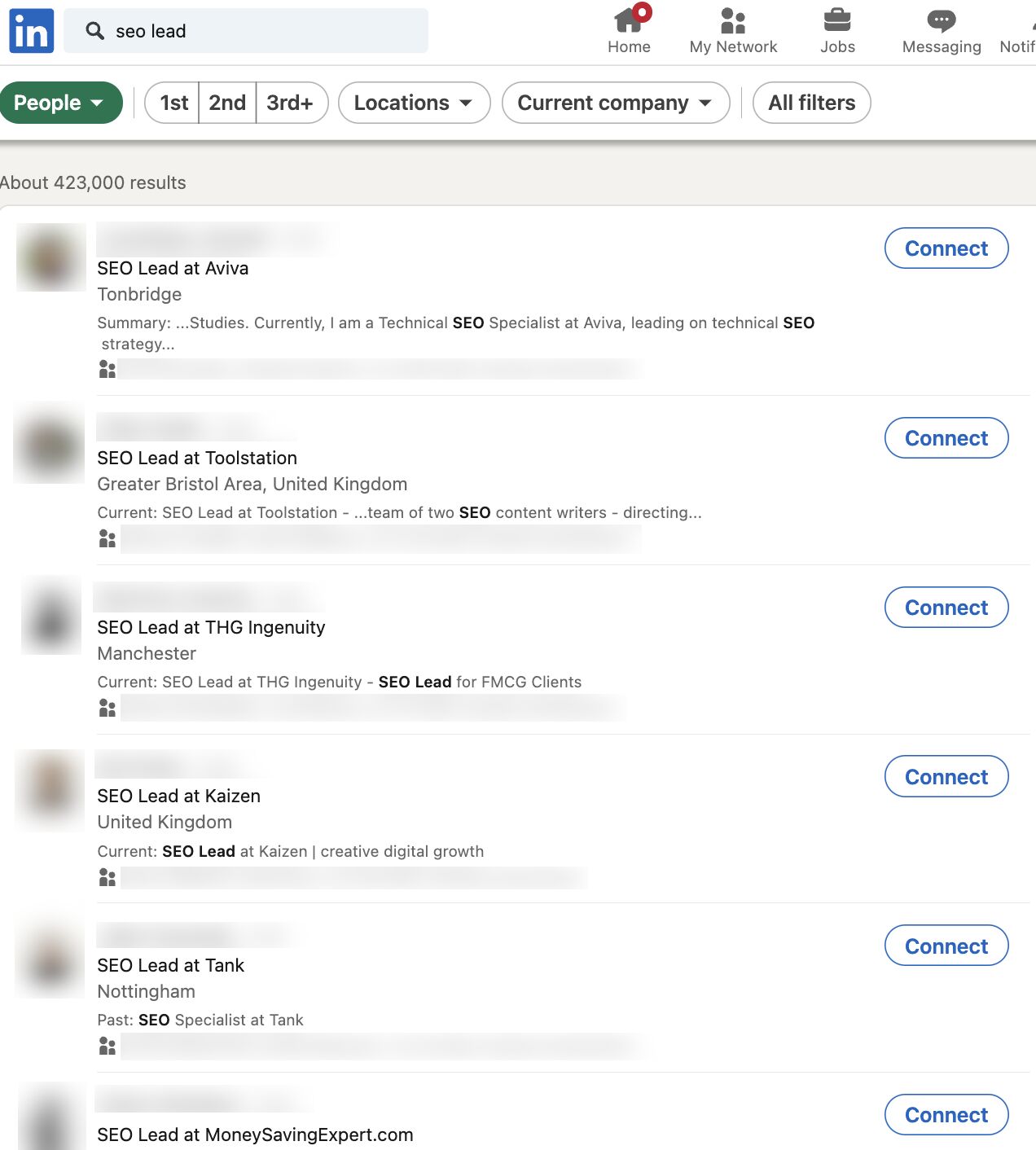
Tip
Look for common career patterns of the SEOs you admire in the industry.
I used this method to understand how my favorite SEOs and people at my company navigated their way from a junior role to a senior role.
For example, when the Head of SEO at the time Kirsty Hulse, joined my team, I added her on LinkedIn and realized that if I wanted to follow in her footsteps, I’d need to start by getting the role of SEO Manager to stand any possible chance of leading SEO campaigns like she was.
The progression in my company was from SEO Executive to Senior SEO Executive (Junior roles in London, UK), but as an outsider coming into the company, Kirsty showed me that it was possible to jump straight to SEO Manager given the right circumstances.


Using Kirsty’s and other SEOs’ profiles, I decided that the next step in my career needed to be SEO Manager, and at some point, I needed to get some experience with a bigger media agency so I could work my way up to leading an SEO campaign with bigger brands.
Sadly, you can’t just rock up to a monthly meeting and start leading a big brand SEO campaign. You’ll need to prove yourself to your line manager first. So how can you do this?
Here’s what I’d suggest you do:
- Create a strong track record with smaller companies.
- Obsessively share your wins with your company, so that senior management will already know you can deliver.
- At your performance review, tell your line manager that you want to work on bigger campaigns and take on more responsibility.
If there’s no hope of working with a big brand at your current job, you might need to consider looking for a new job where there is a recognizable brand. This was what I realized I needed to do if I wanted to get more experience.
Tip
Get recruiters on LinkedIn to give you the inside scoop on which brands or agencies are hiring. Ask them if you have any skill gaps on your resume that could prevent you from getting a job with these companies.
Being critical of your skill gaps can be hard to do. I found the best way to identify them early in my career was to ask other people—specifically recruiters. They had knowledge of the industry and were usually fairly honest as to what I needed to improve.
From this, I realized I lacked experience working with other teams—like PR, social, and development teams. As a junior SEO, your mind is focused 99% on doing SEO, but when you become more senior, your integration with other teams is important to your success.
For this reason, I’d suggest that aspiring SEO Leads should have a good working knowledge of how other teams outside of SEO operate. If you take the time to do this, it will pay dividends later in your career:
- If there are other teams in your company, ask if you can do some onboarding training with them.
- Get to know other team leads within your company and learn how they work.
- Take training courses to learn the fundamentals of other disciplines that complement SEO, such as Python, SQL, or content creation.
Sometimes, employers use skill gaps to pay you less, so it’s crucial to get the skills you need early on…


Examples of other skill gaps I’ve noticed include:
Tip
If you think you have a lot of skill gaps, then you can brush up your skills with our SEO academy. Once you’ve completed that, you can fast-track your knowledge by taking a course like Tom Critchlow’s SEO MBA, or you can try to develop these skills through your job.


As a junior in any company, it can be hard to get your voice heard amongst the senior crowd. Ten years ago, I shared my wins with the team in a weekly group email in the office.
Here’s what you should be sharing:
- Praise from 3rd parties, e.g. “the client said they are impressed with the work this month.”
- Successful performance insights, e.g “following our SEO change, the client has seen X% more conversions this month.”
- Examples of the work you led, e.g. if your leadership and decision-making led to good results, then you need to share it.
At Ahrefs I keep a “wins” document. It’s just a simple spreadsheet that lists feedback on the blog posts I’ve written, the links I’ve earned and what newsletters my post was included in. It’s useful to have a document like this so you have a record of your achievements.
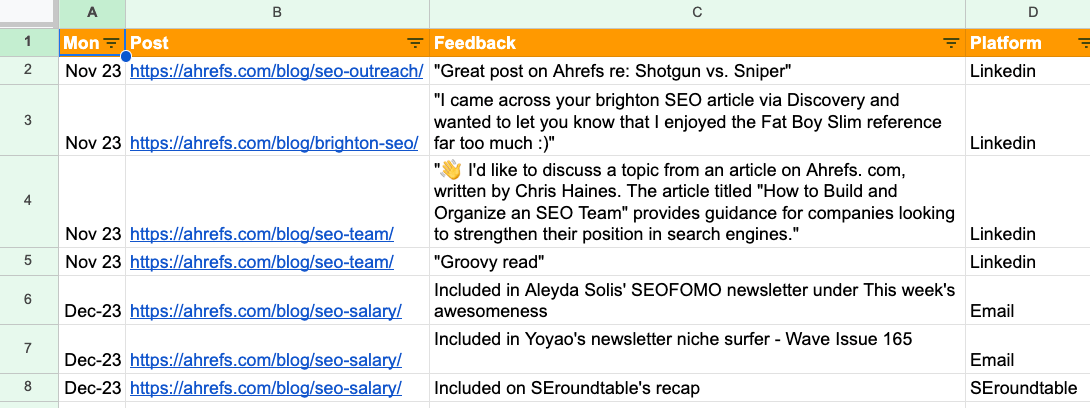

Sidenote.
Junior SEOs sometimes talk about the things “we” achieved as a team rather than what they achieved at the interview stage. If you want the SEO Lead role, remember to talk about what you achieved. While there’s no “I” in team, you also need to advocate for yourself.
One of my first big wins as an SEO was getting a link from an outreach campaign on Buzzfeed. When I went to Brighton SEO later that year and saw Matthew Howells-Barby sharing how he got a Buzzfeed link, I realized that this was not something everyone had done.
So when I did manage to become an SEO Lead, and my team won a prize in Publicis Groupe for our SEO performance, I made sure everyone knew about the work we did. I even wrote a case study on the work for Publicis Groupe’s intranet.
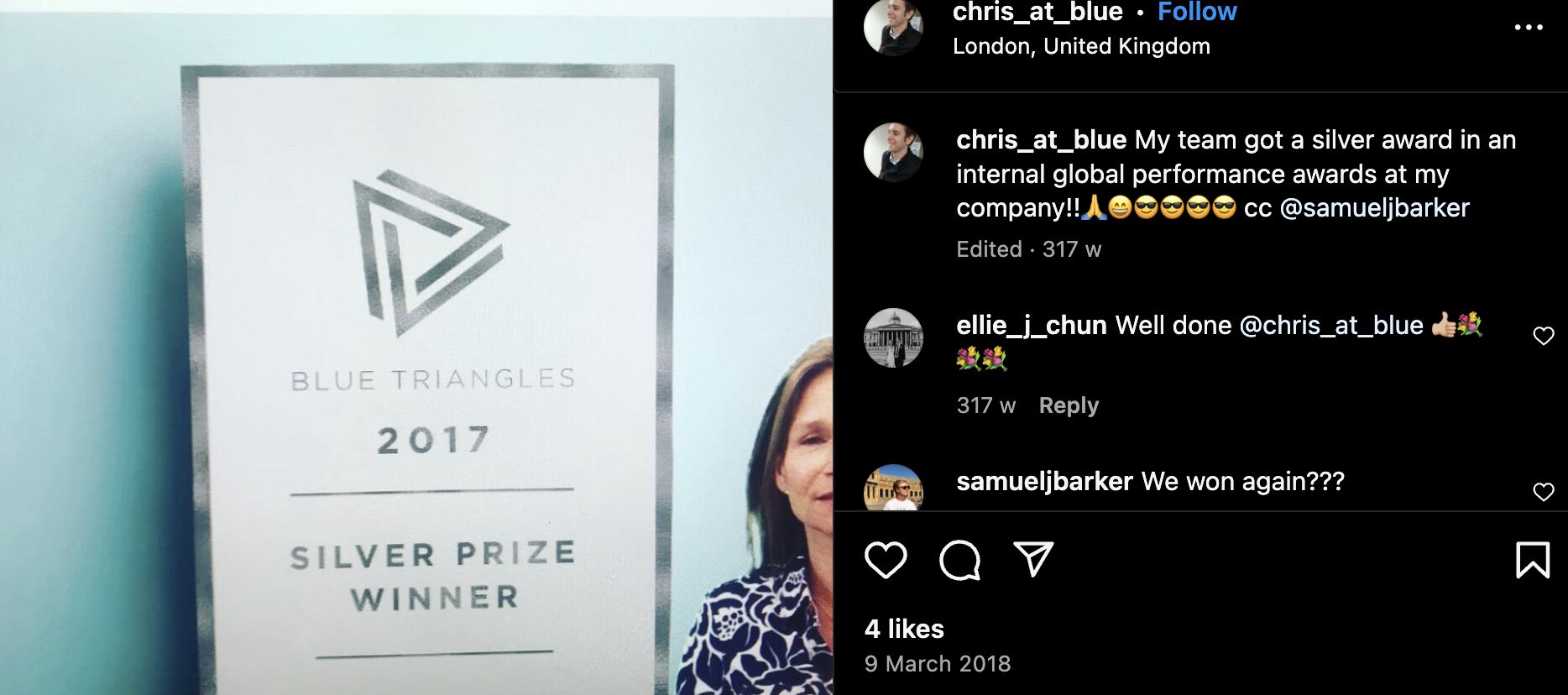

I’ve worked with some incredibly talented people, many of whom have helped me in my career.
I owe my big break to Tim Cripps, Laura Scott, and Kevin Mclaren. Without their support and encouragement, I wouldn’t be where I am today. Even before that, David Schulhof, Jodie Wheeler, and Carl Brooks let me mastermind some bonkers content campaigns that were lucky enough to succeed:


I wasn’t even an SEO Lead at that point, but they gave me the reins and trusted me.
So, how can you find your tribe?
- Speak to recruiters – they might hold the ticket to your next dream job. I spoke to many recruiters early in my career, but only two recruiters delivered for me—they were Natasha Woodford, and Amalia Gouta. Natasha helped me get a job that filled my skill gap, and Amalia helped me get my first SEO Lead role.
- Go to events and SEO conferences, and talk to speakers to build connections outside of your company.
- Use LinkedIn and other social media to interact with other companies or individuals that resonate with you.
Many senior SEO professionals spend most of their online lives on X and LinkedIn. If you’re not using them, you’re missing out on juicy opportunities.


Sharing your expertise on these platforms is one of the easiest ways to increase your chances of getting a senior SEO role. Because, believe it or not, sometimes a job offer can be just a DM away.
Here’s some specific ideas of what you can share:
- Share your thoughts on a trending topic – like the latest Google algorithm update.
- Share what you learned during the course of a campaign.
- Ask the community for their thoughts on a certain topic.
I’ve recently started posting on LinkedIn and am impressed by the reach you can get by posting infrequently on these topics.
Here’s an example of one of my posts where I asked the community for help researching an article I was writing:
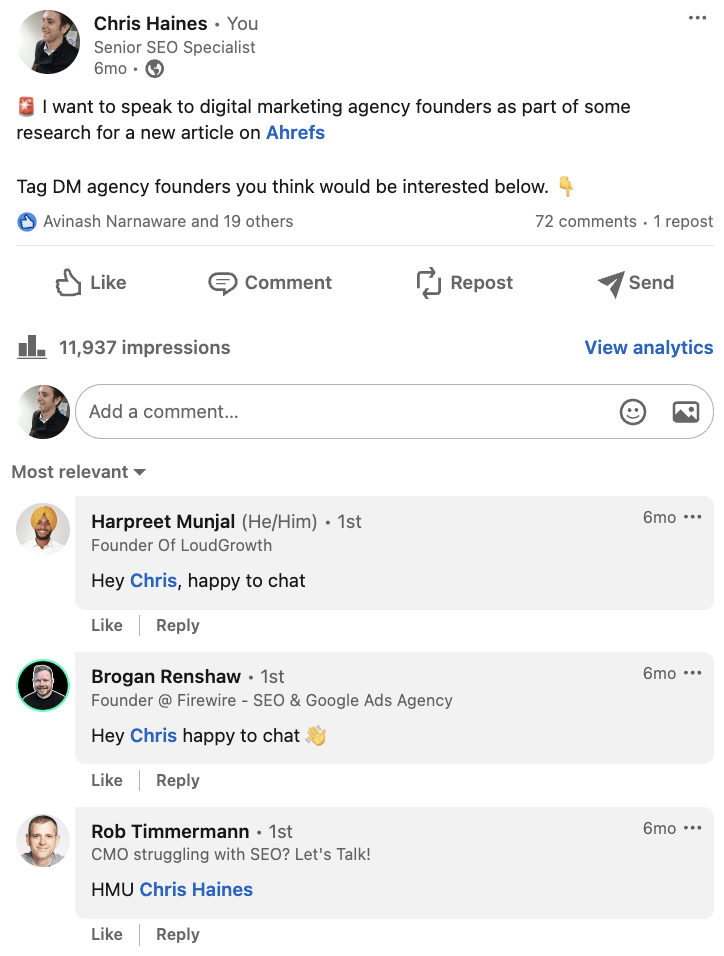

And here is the content performance across the last year from posting these updates.


I’m clearly not a LinkedIn expert—far from it! But as you can see, with just a few months of posting, you can start to make these platforms work for you.
Godard Abel, co-founder of G2, talked on a podcast about conscious leadership. This struck a chord with me recently as I realized that I had practiced some of the principles of conscious leadership—unconsciously.
You can start practicing conscious leadership by asking yourself if your actions are above or below the line. Here are a few examples of above and below-the-line thinking:
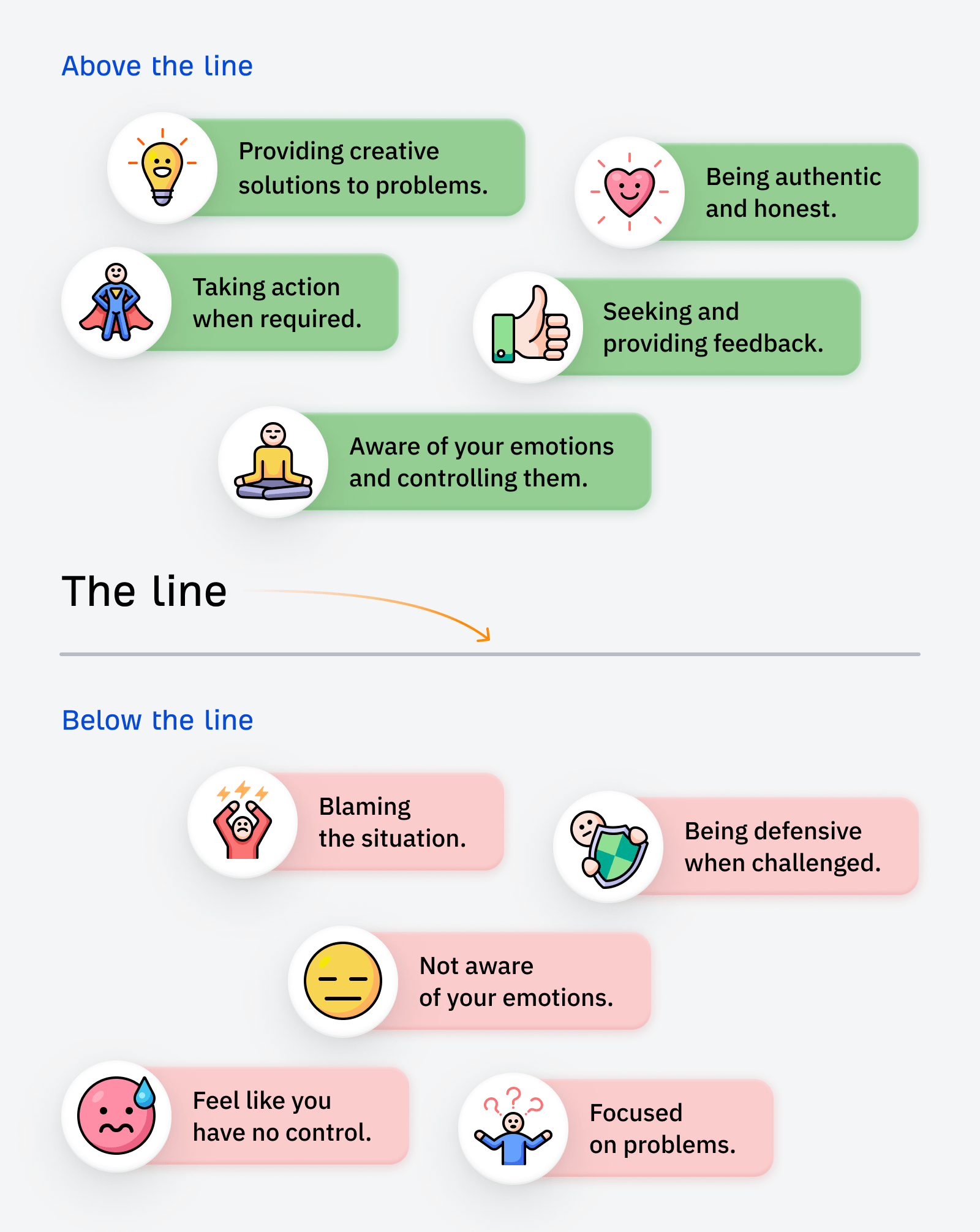

If you want a senior SEO role, I’d suggest shifting your mindset to above-the-line thinking.
In the world of SEO, it’s easy to blame all your search engine woes on Google. We’ve all been there. But a lot of the time, simple changes to your website can make a huge difference—it just takes a bit of effort to find them and make the changes.
SEO is not an exact science. Some stakeholders naturally get nervous if they sense you aren’t sure about what you’re saying. If you don’t get their support early on then you fall at the first hurdle.


To become more persuasive, try incorporating Aristotle’s three persuasive techniques into your conversations.
- Pathos: use logical reasoning, facts, and data to present water-tight arguments.
- Ethos: establish your credibility and ethics through results.
- Logos: make your reports tell a story.


Then sprinkle in language that has a high level of modality:


Some people will be able to do this naturally without even realizing it, but for others, it can be an uphill struggle. It wasn’t easy for me, and I had to learn to adapt the way I talked to stakeholders early on.
The strongest way I found was to appeal to emotions and back up with data from a platform like Ahrefs. Highlight what competitors have done in terms of SEO and the results they’ve earned from doing it.
Sidenote.
You don’t have to follow this tip to the letter, but being aware of these concepts means you’ll start to present more confident and persuasive arguments for justifying your SEO strategies.
When I started in SEO, I had zero connections. Getting a job felt like an impossible challenge.
Once I’d got my first SEO Lead job, it felt stupidly easy to get another one—just through connections I’d made along the way in my SEO journey.
I once got stuck on a delayed train with a senior member of staff, and he told me he was really into Google Local Guides, and he was on a certain high level. He said it took him a few years to get there.
Local Guides is part of Google Maps that allows you submit reviews and other user generated content
When he showed me the app, I realized that you could easily game the levels by uploading lots of photos.
In a “hold my beer” moment, I mass downloaded a bunch of photos, uploaded them to Local Guides and equaled his Local Guide level on the train in about half an hour. He was seething.


One of the photos I uploaded was a half-eaten Subway. It still amazes me that 50,974 people have seen this photo:
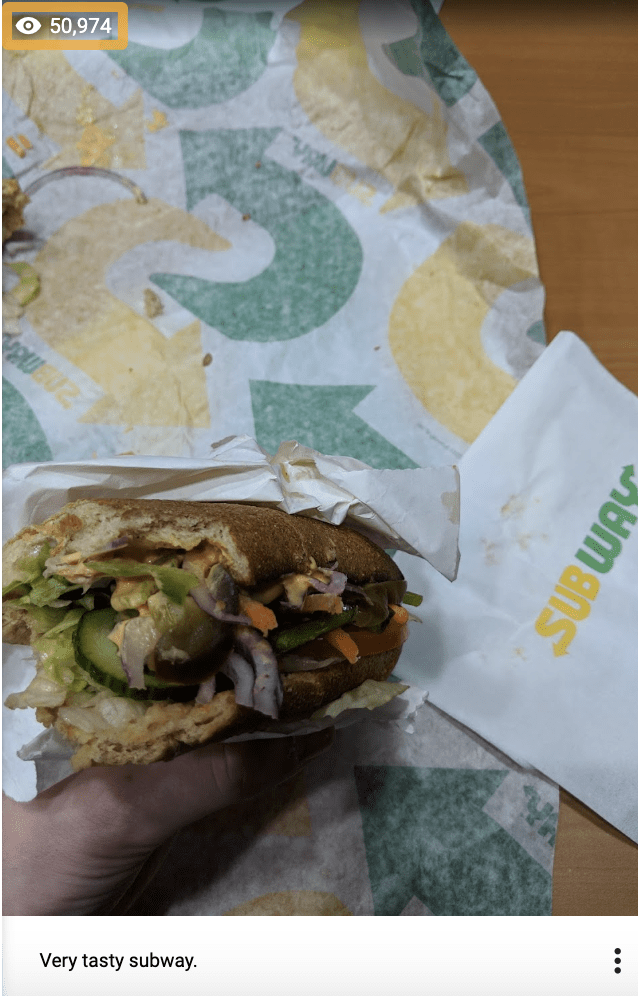

This wasn’t exactly SEO, but the ability to find this ‘hack’ so quickly impressed him, and we struck up a friendship.
The next month that person moved to another company, and then another few months later, he offered me an SEO Lead job.
Tip
Build connections with everyone you can—you never know who you might need to call on next.
Final thoughts
The road to becoming an SEO Lead seems straightforward enough when you start out, but it can quickly become long and winding.
But now armed with my tips, and a bucket load of determination, you should be able to navigate your way to an SEO Lead role much quicker than you think.
Lastly, if you want any more guidance, you can always ping me on LinkedIn. 🙂
SEO
7 Content Marketing Conferences to Attend in 2024
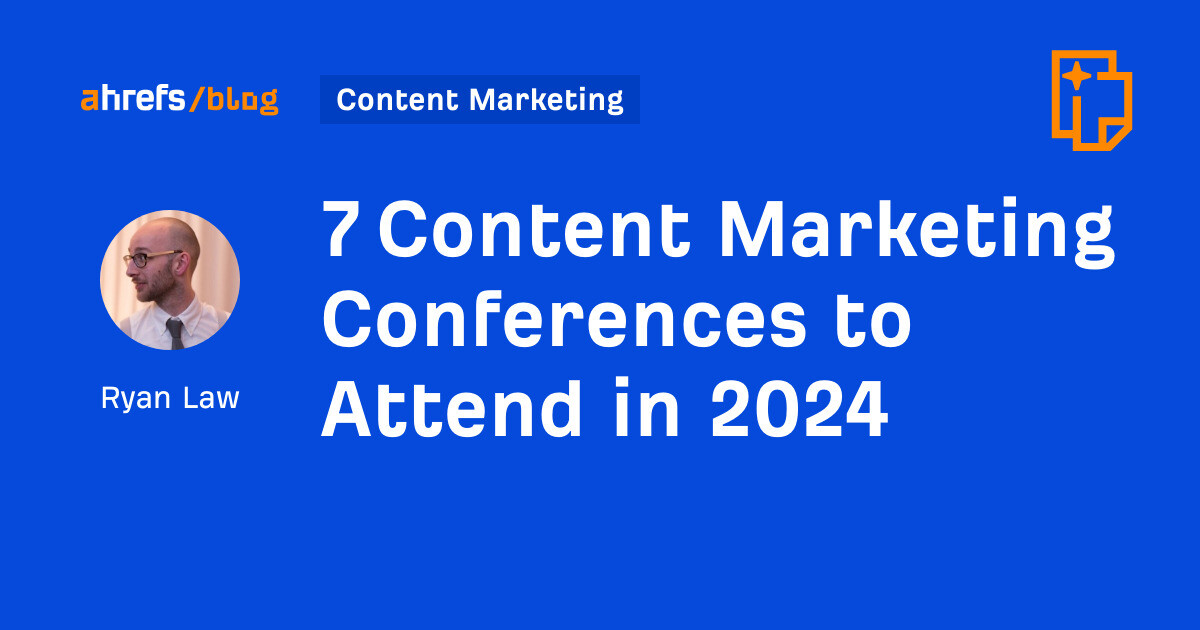
I spend most of my days sitting in front of a screen, buried in a Google Doc. (You probably do too.)
And while I enjoy deep work, a few times a year I get the urge to leave my desk and go socialize with other human beings—ideally on my employer’s dime 😉
Conferences are a great excuse to hang out with other content marketers, talk shop, learn some new tricks, and pretend that we’re all really excited about generative AI.
Without further ado, here are the biggest and best content marketing conferences happening throughout the rest of 2024.
Dates: May 5–7
Prices: from $795
Website: https://cex.events/
Location: Cleveland, OH
Speakers: B.J. Novak, Ann Handley, Alexis Grant, Justin Welsh, Mike King
CEX is designed with content entrepreneurs in mind (“contenpreneurs”? Did I just coin an awesome new word?)—people that care as much about the business of content as they do the craft.
In addition to veteran content marketers like Ann Handley and Joe Pulizi waxing lyrical about modern content strategy, you’ll find people like Justin Welsh and Alexis Grant exploring the practicalities of quitting your job and becoming a full-time content creator.
Here’s a trailer for last year’s event:
Sessions include titles like:
- Unlocking the Power of Book Publishing: From Content to Revenue
- Quitting A $200k Corporate Job to Become A Solo Content Entrepreneur
- Why You Should Prioritize Long-Form Content
(And yes—Ryan from The Office is giving the keynote.)
Dates: Jun 3–4
Location: Seattle, WA
Speakers: Wil Reyolds, Bernard Huang, Britney Muller, Lily Ray
Prices: from $1,699
Website: https://moz.com/mozcon
Software company Moz is best known in the SEO industry, but its conference is popular with marketers of all stripes. Amidst a lineup of 25 speakers there are plenty of content marketers speaking, like Andy Crestodina, Ross Simmonds, and Chima Mmeje.
Check out this teaser from last year’s event:
This year’s talks include topics like:
- Trust and Quality in the New Era of Content Discovery
- The Power of Emotion: How To Create Content That (Actually) Converts
- “E” for Engaging: Why The Future of SEO Content Needs To Be Engaging
Dates: Sep 18–20
Location: Boston, MA
Speakers: TBC
Prices: from $1,199
Website: https://www.inbound.com/
Hosted by content marketing OG HubSpot, INBOUND offers hundreds of talks, deep dives, fireside chats, and meetups on topics ranging from brand strategy to AI.
Here’s the recap video:
I’ve attended my fair share of INBOUNDs over the years (and even had a beer with co-founder Dharmesh Shah), and always enjoy the sheer choice of events on offer.
Keynotes are a highlight, and this year’s headline speaker has a tough act to follow: Barack Obama closed out the conference last year.
Dates: Oct 22–23
Location: San Diego, CA
Speakers: TBC
Prices: from $1,199
Website: https://www.contentmarketingworld.com/
Arguably the content marketing conference, Content Marketing World has been pumping out content talks and inspiration for fourteen years solid.
Here’s last year’s recap:
The 2024 agenda is in the works, but last year’s conference explored every conceivable aspect of content marketing, from B2C brand building through to the quirks of content for government organizations, with session titles like:
- Government Masterclass: A Content Marketing Strategy to Build Public Trust
- A Beloved Brand: Evolving Zillow’s Creative Content Strategy
- Evidence-Based SEO Strategies: Busting “SEO Best Practices” and Other Marketing Myths
Dates: Oct 24–25
Location: Singapore
Speakers: Andy Chadwick, Nik Ranger, Charlotte Ang, Marcus Ho, Victor Karpenko, Amanda King, James Norquay, Sam Oh, Patrick Stox, Tim Soulo (and me!)
Prices: TBC
Website: https://ahrefs.com/events/evolve2024-singapore
That’s right—Ahrefs is hosting a conference! Join 500 digital marketers for a 2-day gathering in Singapore.
We have 20 top speakers from around the world, expert-led workshops on everything from technical SEO to content strategy, and tons of opportunities to rub shoulders with content pros, big brands, and the entire Ahrefs crew.
I visited Singapore for the first time last year and it is really worth the trip—I recommend visiting the Supertree Grove, eating at the hawker markets in Chinatown, and hitting the beach at Sentosa.
If you need persuading, here’s SEO pro JH Scherck on the Ahrefs podcast making the case for conference travel:
And to top things off, here’s a quick walkthrough of the conference venue:
Dates: Oct 27–30
Location: Portland, OR
Speakers: Relly Annett-Baker, Fawn Damitio, Scott Abel, Jennifer Lee
Prices: from $1,850
Website: https://lavacon.org/
LavaCon is a content conference with a very technical focus, with over 70 sessions dedicated to helping companies solve “content-related business problems, increase revenue, and decrease production costs”.
In practice, that means speakers from NIKE, Google, Meta, Cisco, and Verizon, and topics like:
- Operationalizing Generative AI,
- Taxonomies in the Age of AI: Are they still Relevant?, and
- Out of Many, One: Building a Semantic Layer to Tear Down Silos
Here’s the recap video for last year’s conference:
Dates: Nov 8
Location: London
Speakers: Nick Parker, Tasmin Lofthouse, Dan Nelken, Taja Myer
Prices: from £454.80
Website: https://www.copywritingconference.com/
CopyCon is a single-day conference in London, hosted by ProCopywriters (a membership community for copywriters—I was a member once, many years ago).
Intended for copywriters, creatives, and content strategists, the agenda focuses heavily on the qualitative aspects of content that often go overlooked—creative processes, tone of voice, and creating emotional connections through copy.
It’s a few years old, but this teaser video shares a sense of the topics on offer:
This year’s talks include sessions like:
- The Mind-Blowing Magic of Tone of Voice,
- The Power of AI Tools as a Content Designer, and the beautifully titled
- Your Inner Critic is a Ding-Dong.
(Because yes, your inner critic really is a ding-dong.)
Final thoughts
These are all content-specific conferences, but there are a ton of content-adjacent events happening throughout the year. Honourable mentions go to DigiMarCon UK 2024 (Aug 29–30, London, UK), Web Summit (Nov 11–14, Lisbon, Portugal), and B2B Forum (Nov 12–14, Boston, MA).
I’ve focused this list solely on in-person events, but there are also online-only conferences available, like ContentTECH Summit (May 15–16).
Heading to a content conference that I haven’t covered? Share your recommendation with me on LinkedIn or X.
-

 PPC4 days ago
PPC4 days ago19 Best SEO Tools in 2024 (For Every Use Case)
-

 PPC7 days ago
PPC7 days ago4 New Google Ads Performance Max Updates: What You Need to Know
-

 MARKETING6 days ago
MARKETING6 days agoWill Google Buy HubSpot? | Content Marketing Institute
-
SEARCHENGINES6 days ago
Daily Search Forum Recap: April 16, 2024
-

 SEO6 days ago
SEO6 days agoGoogle Clarifies Vacation Rental Structured Data
-

 MARKETING6 days ago
MARKETING6 days agoStreamlining Processes for Increased Efficiency and Results
-
SEARCHENGINES5 days ago
Daily Search Forum Recap: April 17, 2024
-

 PPC7 days ago
PPC7 days agoHow to Collect & Use Customer Data the Right (& Ethical) Way















You must be logged in to post a comment Login